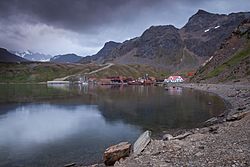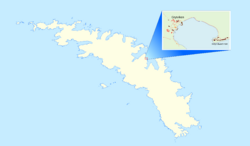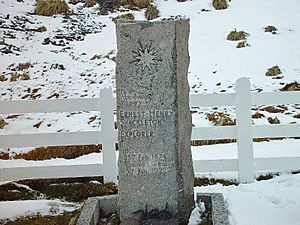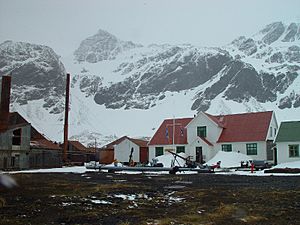Grytviken facts for kids
Quick facts for kids
Grytviken
|
|
|---|---|
 |
|

Location of Grytviken and King Edward Point
|
|
| Country | |
| British Overseas Territory | |
| Population
(2018)
|
|
| • Total | 3 (summer) |
| Time zone | UTC−2 (GST) |
Grytviken is a small village on South Georgia in the South Atlantic Ocean. It used to be a very important whaling station and the biggest settlement on the island. Grytviken is located in a safe spot called King Edward Cove, which is part of Cumberland East Bay. This area is known as the best harbor on the island.
The name "Grytviken" means "pot bay." It was given in 1902 by the Swedish Antarctic Expedition. They found old English pots used to melt down seal fat there. The settlement was officially started again on November 16, 1904, by a Norwegian explorer named Carl Anton Larsen.
Grytviken was built on flat, protected land with plenty of fresh water. Even though it was the largest settlement, the island's government was based nearby at King Edward Point. The whaling station closed in December 1966. This happened because there were not enough whales left to make it profitable.
Today, Grytviken does not have people living there all the time. However, researchers, British government workers, and military staff visit sometimes. During the summer, a few people stay to run the South Georgia Museum. Grytviken is also a popular place for Antarctic cruise ships to visit. Many tourists come to see the graves of famous polar explorers Sir Ernest Shackleton and Frank Wild in the Grytviken graveyard.
Contents
History
The Start of Grytviken
Grytviken was founded on November 16, 1904, by a Norwegian sea captain named Carl Anton Larsen. He built it as a whaling station for his company, Compañía Argentina de Pesca. The station was very successful, catching 195 whales in its first season.
Whalers used every part of the whales they caught. They melted down the blubber, meat, bones, and organs to get oil. The bones and meat were also turned into fertilizer and animal food. Elephant seals were also hunted for their fat.
About 300 men worked at the station during its busiest times. They worked during the southern summer, from October to March. A few men stayed through the winter to take care of the boats and the factory. Every few months, a ship would bring supplies and take away the whale oil and other products. The next year, the Argentine Government set up a weather station there.
Carl Anton Larsen, who started Grytviken, became a British citizen in 1910. He said he wanted to live in South Georgia for a long time. His family, including his wife, three daughters, and two sons, lived with him in Grytviken.
Larsen managed the building of Grytviken. It was a huge job, done by sixty Norwegians. They arrived on November 16 and started making whale oil by December 24, 1904.

Larsen chose the spot for the whaling station during a visit in 1902. He was commanding the ship Antarctic for the Swedish Antarctic Expedition. During that trip, the name Grytviken ("The Pot Cove") was given by a Swedish scientist, Johan Gunnar Andersson. He explored the area and found many old items from seal hunters. These included a small boat and several pots used to boil seal oil. One of these pots, marked 'Johnson and Sons, Wapping Dock, London,' is now in the South Georgia Museum.
Managers and other important people at the whaling stations often had their families living with them. One example was Fridthjof Jacobsen. His wife, Klara Olette Jacobsen, gave birth to two of their children in Grytviken. Their daughter, Solveig Gunbjørg Jacobsen, was the first child ever born south of the Antarctic Convergence. She was born on October 8, 1913. A few more children have been born on South Georgia since then, even on visiting private boats.
The number of whales in the seas around the island dropped a lot over the next sixty years. The station closed in December 1966. By then, there were so few whales that it was no longer worth hunting them. Even today, the shore around Grytviken is covered with whale bones. There are also rusty remains of the old whale oil factories and abandoned whaling ships.
Ernest Shackleton's Connection

Grytviken is famous for its link to the explorer Sir Ernest Shackleton. Shackleton's Imperial Trans-Antarctic Expedition left London on August 1, 1914. Their ship, the Endurance, got stuck in thick ice in the Weddell Sea in January 1915. The ice crushed the ship on October 27, 1915.
The 28 crew members escaped to Elephant Island off Antarctica. They brought three small boats with them. Shackleton and five other men bravely sailed one of these boats, the James Caird, to the southern coast of South Georgia. They landed at Cave Cove and camped at Peggotty Bluff. From there, they hiked across the island to Stromness. From Grytviken, Shackleton organized a rescue mission to save the rest of his men.
Shackleton returned to Grytviken during another trip, the Shackleton–Rowett Expedition. He sadly died there at age 47, shortly after New Year's Day. His wife chose South Georgia as his final resting place. His grave is located south of Grytviken, next to the graves of whalers who died on the island.
On November 27, 2011, the ashes of Frank Wild were buried next to Shackleton's grave. Wild was Shackleton's "right-hand man." The stone marking his grave says, "Frank Wild 1873–1939, Shackleton's right-hand man." Wild's family and Shackleton's granddaughter attended a special service.
The Falklands War
During the Falklands War in 1982, Grytviken was taken over by Argentine forces. This happened in early April after a short fight with Royal Marines. However, the Royal Marines, along with the SAS and SBS, took the settlement back three weeks later. This time, no shots were fired.
On April 3, 1982, an Argentine ship, the ARA Bahía Paraíso, landed Argentine marines. They attacked a small group of 22 Royal Marines at Grytviken. The battle lasted two hours. An Argentine ship, the ARA Guerrico, was damaged, and an Argentine helicopter was shot down. Three Argentine soldiers were killed and several were injured. One British soldier was injured.
While the British government workers and military were removed from Grytviken, 15 other Britons remained hidden. The losses suffered by Argentina at Grytviken stopped them from taking over the rest of the island. British forces still controlled Bird Island and other camps.
On April 25, the Royal Navy damaged and captured an Argentine submarine, the ARA Santa Fe, near South Georgia. The Argentine soldiers in Grytviken then gave up without fighting. The next day, the Argentine group in Leith Harbour also surrendered. One prisoner, Felix Artuso, was accidentally shot and buried at Grytviken Cemetery.
Grytviken Today

Grytviken and the area around it have been named an Area of Special Tourist Interest (ASTI).
Grytviken is a popular stop for cruise ships visiting Antarctica. Tourists often land to visit Shackleton's grave. The South Georgia Museum is located in the old manager's house of the whaling station. It is open during the summer tourist season.
The station's church is the only building still used for its original purpose. Services are held there sometimes. Several weddings have taken place in Grytviken. The first was on February 24, 1932.
On January 28, 2007, a service was held to remember Anders Hansen, a Norwegian whaler buried in Grytviken Cemetery in 1943. It also celebrated the baptism of his great-great-grandson, Axel Wattø Eide, which happened in Oslo on the same day.
Many old shipwrecks can be seen around Grytviken. Ships like the Petrel, Dias, and Albatross were left to rust after many years of service.
Geography
Climate
Grytviken has a tundra climate. This means it has long, cold winters and short, cool summers.
| Climate data for Grytviken/King Edward Point (Köppen ET) (2006–2020) | |||||||||||||
|---|---|---|---|---|---|---|---|---|---|---|---|---|---|
| Month | Jan | Feb | Mar | Apr | May | Jun | Jul | Aug | Sep | Oct | Nov | Dec | Year |
| Record high °C (°F) | 23.0 (73.4) |
23.0 (73.4) |
21.6 (70.9) |
21.7 (71.1) |
17.1 (62.8) |
14.1 (57.4) |
14.9 (58.8) |
13.9 (57.0) |
16.0 (60.8) |
20.2 (68.4) |
20.4 (68.7) |
26.4 (79.5) |
26.4 (79.5) |
| Mean daily maximum °C (°F) | 10.0 (50.0) |
10.8 (51.4) |
9.4 (48.9) |
6.1 (43.0) |
3.9 (39.0) |
2.2 (36.0) |
1.7 (35.1) |
2.4 (36.3) |
4.5 (40.1) |
6.9 (44.4) |
8.9 (48.0) |
9.8 (49.6) |
6.4 (43.5) |
| Daily mean °C (°F) | 6.3 (43.3) |
6.9 (44.4) |
5.8 (42.4) |
3.2 (37.8) |
1.0 (33.8) |
−0.4 (31.3) |
−1.2 (29.8) |
−0.6 (30.9) |
1.1 (34.0) |
3.3 (37.9) |
5.0 (41.0) |
6.1 (43.0) |
3.0 (37.5) |
| Mean daily minimum °C (°F) | 2.6 (36.7) |
3.1 (37.6) |
2.2 (36.0) |
0.2 (32.4) |
−2.0 (28.4) |
−4.6 (23.7) |
−4.0 (24.8) |
−3.7 (25.3) |
−2.3 (27.9) |
−0.3 (31.5) |
1.0 (33.8) |
2.3 (36.1) |
−0.5 (31.2) |
| Record low °C (°F) | −2.5 (27.5) |
−3.0 (26.6) |
−4.0 (24.8) |
−7.0 (19.4) |
−10.0 (14.0) |
−11.2 (11.8) |
−15.1 (4.8) |
−13.0 (8.6) |
−11.0 (12.2) |
−9.5 (14.9) |
−5.0 (23.0) |
−4.0 (24.8) |
−15.1 (4.8) |
| Average precipitation mm (inches) | 92 (3.6) |
114 (4.5) |
136 (5.4) |
139 (5.5) |
137 (5.4) |
135 (5.3) |
149 (5.9) |
149 (5.9) |
92 (3.6) |
80 (3.1) |
93 (3.7) |
88 (3.5) |
1,394 (54.9) |
| Average precipitation days (≥ 0.1 mm) | 12 | 13 | 14 | 14 | 12 | 15 | 15 | 14 | 11 | 12 | 11 | 11 | 154 |
| Average relative humidity (%) | 72 | 69 | 69 | 70 | 74 | 75 | 74 | 73 | 72 | 70 | 69 | 71 | 72 |
| Mean monthly sunshine hours | 152 | 160 | 127 | 66 | 34 | 12 | 22 | 74 | 123 | 171 | 174 | 167 | 1,282 |
| Source 1: Meteomanz | |||||||||||||
| Source 2: Globalbioclimatics/Salvador Rivas-Martínez p(recipitation 1901–1950)DMI/Danish Meteorology Institute (sun, humidity, and precipitation days 1931–1960)Météo Climat (extremes) | |||||||||||||
Images for kids
-
Whaling and sealing ships at Grytviken
-
Thatcher Peninsula with King Edward Cove and Grytviken.
See also
 In Spanish: Grytviken para niños
In Spanish: Grytviken para niños








